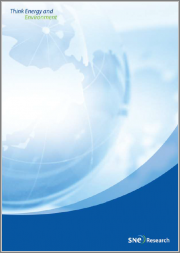
|
시장보고서
상품코드
1403147
<2024> 차세대 전지용 리튬메탈 음극재 기술개발 현황 및 시장 전망<2024> Technology Development Status and Market Forecast of Lithium Metal Anode Materials for Next-Gen Batteries |
||||||
21세기 들어 심각해지는 기후 변화와 환경 규제 및 다양한 규제를 통해 환경 보전과 지속 가능한 사회를 이룩하고자 하는 제반 활동을 활발히 하는 가운데 재생 가능 및 청정 에너지 기술 개발 필요성이 강하게 대두되고 있습니다. 이차전지 산업은 친환경 에너지를 대표하는 산업으로, 운송수단이 내연기관에서 전기 자동차로 탈바꿈하면서 다양한 종류의 리튬이온 전지에 대한 연구가 활발하게 이루어지고 있습니다.
1990년대 리튬 이온 배터리 상용화 이후 지난 수십 년 동안 상업용 전자 제품과 전기차에 전력을 공급하는데 큰 성공을 거두었습니다. 그러나 기존 흑연 음극을 사용한 리튬 이온 전지는 음극의 낮은 이론 용량(-372 mAh/g)과 부피 용량(-735 mAh/cm3)으로 리튬 이온 전지가 달성하는 에너지 밀도의 향상을 제한합니다. 리튬 이차전지의 증가하는 수요량을 충족시키기 위해서는 기존의 리튬 이온 전지를 넘어선 새로운 배터리 기술이 필요합니다.
리튬 메탈은 이론상 용량(-3860 mAh/g)이 매우 높고 가장 낮은 전기화학적 전위(-3.04 V vs. 수소 기준 전극) 뿐만 아니라 가장 낮은 밀도(0.53g/cm3)를 갖습니다. 이러한 특성으로 인해 리튬 메탈 음극은 높은 단위 무게 및 단위 부피당 용량과 출력을 낼 수 있는 가장 유망한 소재로 평가됩니다.
이외에도 음극에 리튬이 없는 기재를 사용하거나 극소량의 리튬만을 적용하는 무음극(Anode-less/Anode-free) 기술 역시 활발히 연구가 이루어지고 있습니다. 음극재는 배터리 충전 속도와 수명에 영향을 주므로 이를 없애거나 줄이면 그만큼 배터리의 에너지 밀도가 높아지며 수명이 길어지는 장점이 있습니다.
본 보고서는 향후 유망한 음극재로 손꼽히는 리튬메탈 및 무음극 기술을 중심으로 한 최신 동향을 다루었습니다. 또한 한·중·일 및 북미와 유럽 등 50여개에 달하는 리튬메탈 관련 업체와 연구기관의 기술 및 개발 현황에 대해 살펴보았습니다. 마지막으로 시장 부분은 향후 펼쳐질 차세대 전지 시장을 배경으로 하여 xEV 등 어플리케이션에 적용되는 상황을 고려하여 2030년까지의 리튬메탈 음극재 시장의 수요와 그 규모를 전망하였습니다.
*본 보고서의 Strong Point
- ① Li metal 제조 기술 및 issue 총망라
- ② Li metal anode 및 Anodeless 전반적인 연구개발 동향 파악
- ③ Li metal anode 관련 주요 Player별 기술 동향 및 전략
- Contents -
1. 서론
- 1.1 리튬이온 이차전지 요구 특성
- 1.2 리튬이온 이차전지 개발 동향
2. 음극재 기술 및 개발 현황
- 2.1 리튬이온 이차전지 음극재 개요
- 2.2 리튬이온 이차전지 음극재 개발 동향
- 2.2.1 차세대 음극재 개발 방향(Li-metal anode)
- 2.2.2 차세대 음극재 개발 방향(anodeless)
3. 리튬메탈 제조 기술 및 공급 현황
- 3.1 리튬 생산 및 공급현황
- 3.1.1 Global Li reserves
- 3.1.2 Global Li production
- 3.1.3 Li resources : Mineral
- 3.1.4 Li resources : Ores
- 3.1.5 Li resources : Brines
- 3.1.6 Li 소재 공급구조
- 3.1.7 Li 수요 전망
- 3.2 Li metal 제조 기술
- 3.2.1 Li 소재 기술
- 3.2.2 Li 박형화 기술
- 3.3 Li metal 제조 issue
- 3.3.1 Li 박형화 공정 한계
- 3.3.2 고비용 구조
4. Li metal anode 연구개발 동향 및 주요 issue
- 4.1 Li metal anode 개발 역사
- 4.1.1 개발 역사 개요
- 4.1.2 Li metal battery(LMB) 역사
- 4.1.3 Li metal battery(LMB) 최초 개발
- 4.1.4 Li ion battery(LIB) 개발 및 시장지배
- 4.1.5 Li metal battery(LMB) 필요성 대두
- 4.2 Li metal anode issue
- 4.2.1 Li dendritic growth
- 4.2.2 SEI Layer issue
- 4.3 Li metal anode 연구개발 동향
- 4.3.1 인위적인 표면 보호막 (Artificial SEI)
- 4.3.2 신구조체 설계 (New structure design)
- 4.3.3 전해질 변경 (Electrolyte modification)
- 4.3.4 무음극 설계 (Anodeless design)
5. Li metal anode 업체별 개발 현황
- 5.1 개요
- 5.2 아시아 업체
- 5.2.1 삼성SDI
- 5.2.2 LGES
- 5.2.3 SK on
- 5.2.4 CATL
- 5.2.5 EVE
- 5.2.6 Prologium
- 5.2.7 Qingtao Energy
- 5.2.8 Welion
- 5.2.9 현대자동차
- 5.2.10 POSCO
- 5.2.11 니바코퍼레이션
- 5.2.12 Ulvac Inc
- 5.2.13 Santoku
- 5.2.14 Honjo metal
- 5.2.15 Wuxi Sunenergy Lithium Industrial
- 5.2.16 China Energy Lithium
- 5.2.17 Ganfeng Lithium
- 5.2.18 Tianqi Lithium
- 5.2.19 Montavista
- 5.2.20 Shenzen Inx Technology
- 5.2.21 BTR
- 5.2.22 Softbank 차세대 전지 Lab
- 5.2.23 산업기술총합연구소(AIST)
- 5.2.24 물질재료연구기구(NIMS)-ALCA SPRING
- 5.3 유럽 업체
- 5.3.1 Blue Solutions
- 5.3.2 Volkswagen
- 5.3.3 Mercedes-Benz
- 5.3.4 SIDRABE
- 5.3.5 IMEC
- 5.4 북미 업체
- 5.4.1 SES
- 5.4.2 QuantumScape
- 5.4.3 Solid Power
- 5.4.4 Factorial Energy
- 5.4.5 Soelect
- 5.4.6 TeraWatt
- 5.4.7 Hydro Quebec
- 5.4.8 Brightvolt
- 5.4.9 Sion Power
- 5.4.10 SEEO
- 5.4.11 Cuberg
- 5.4.12 Enpower Greentech
- 5.4.13 PolyPlus
- 5.4.14 Sepion Technologies Inc
- 5.4.15 Ion Storage Systems
- 5.4.16 Sakuu
- 5.4.17 GM
- 5.4.18 Ford
- 5.4.19 Li Metal Corp
- 5.4.20 Ionic Materials
- 5.4.21 Albemarle
- 5.4.22 SQM
- 5.4.23 Livent Corp
- 5.4.24 Pure Lithium Corp
- 5.5 주요 업체 요약
6. Li metal anode 시장 전망
- 6.1 Li metal anode 시장 전망 개요
- 6.1.1 Li metal anode 전지 종류 및 원가 구성
- 6.1.2 Li metal anode 적용 Roadmap
- 6.1.3 Li metal anode 전지 상업화 시나리오
- 6.2 Li metal anode 시장전망
- 6.2.1 Li metal anode 수요 전망
- 6.2.2 Li metal anode 가격 전망
- 6.2.3 Li metal anode 가격 전망 근거
- 6.2.4 Li metal Battery (SLMB) 시장규모 전망
- 6.2.5 Li metal Battery (SLMB) 사용 비중 전망
- 6.2.6 Li metal Battery (SLMB) Application별 전망
With the growing seriousness of climate change in the 21st century, the need for renewable and clean energy technology development has become increasingly urgent. Amidst various regulations and active efforts to achieve environmental protection and a sustainable society through environmental regulations, the secondary battery industry is a leading eco-friendly energy industry. As transportation shifts from internal combustion engines to electric vehicles, research on various types of lithium-ion batteries is actively underway.
Since their commercialization in the 1990s, lithium-ion batteries have been highly successful in powering various electronic devices and electric vehicles. However, conventional lithium-ion batteries with graphite anodes have limitations in achieving high energy density due to the low theoretical capacity (~372 mAh/g) and volumetric capacity (~735 mAh/cm3) of the anode. Meeting the growing demand for lithium secondary batteries requires the development of new battery technologies beyond conventional lithium-ion batteries.
Lithium metal has a very high theoretical capacity (~3860 mAh/g), the lowest electrochemical potential (-3.04 V vs. SHE), and the lowest density (0.53 g/cm3). Due to these characteristics, lithium metal is considered the most promising material for achieving high energy and power density per unit weight and volume.
In addition, anode-less/anode-free technologies, which use lithium-free materials for the anode or apply only a small amount of lithium, are also being actively researched. Since the anode material affects the charging speed and lifespan of the battery, eliminating or reducing it has the advantage of increasing the energy density of the battery and increasing its lifespan.
This report covers the latest trends centered on lithium metal and anode-free technologies, which are considered promising anode materials for the future. It also examined the technology and development status of more than 50 lithium metal-related companies and research institutes in Korea, China, Japan, North America, and Europe. Lastly, the market analysis section predicts the demand and size of the lithium metal anode material market by 2030, taking into account the utilization in xEVs and other emerging applications within the next-generation battery market landscape.
Strong Points of this report:
- 1. Li metal manufacturing technologies and issues
- 2. Understanding the overall R&D trends of Li metal anode and anodeless
- 3.Technology trends and strategies of major players related to Li metal anodes
Table of Contents
1. Introduction
- 1.1. Required Characteristics of Li-Ion Secondary Batteries
- 1.2. Development Trends of Li-Ion Secondary Batteries
2. Anode Material Technology and Development Status
- 2.1. Overview of Li-Ion Secondary Battery Anode Materials
- 2.2. Development Trends in Li-Ion Secondary Battery Anode Materials
- 2.2.1. Future Developments in Anode Materials (Li-metal anode)
- 2.2.2. Future Developments in Anode Materials (Anodeless)
3. Li Metal Manufacturing Technology and Supply Status
- 3.1. Lithium Production and Supply Status
- 3.1.1. Global Li reserves
- 3.1.2. Global Li production
- 3.1.3. Li resources: Mineral
- 3.1.5. Li resources: Ores
- 3.1.6. Li resources: Brines
- 3.1.7. Lithium Material Supply Structure
- 3.1.8. Li Demand Outlook
- 3.2. Li Metal Manufacturing Technology
- 3.2.1. Li Material Technology
- 3.2.2. Li Thin-Film Technology
- 3.3. Li Thin-Film Technology
- 3.3.1. Li Thinning Process Limitations
- 3.3.2. High-Cost Structure
4. Li Metal Anode R&D Trend and Main Issue
- 4.1. Li Metal Anode Development History
- 4.1.1. Development History Overview
- 4.1.2. Li metal battery(LMB) History
- 4.1.3. Initial Development of the Li Metal Battery (LMB)
- 4.1.4. Li Ion Battery Development and Market Dominance
- 4.1.5. Growing Need for Lithium Metal Batteries (LMBs)
- 4.2. Li Metal Anode Main Issue
- 4.2.1. Li Dendritic Growth
- 4.2.2. SEI Layer issue
- 4.3. Li Metal Anode R&D Trends
- 4.3.1. Artificial SEI
- 4.3.2. New structure design
- 4.3.3. Electrolyte modification
- 4.3.4. Anodeless design
5. Development Status of Li Metal Anode by Company
- 5.1. Overview
- 5.2. Asian Companies
- 5.2.1. Samsung SDI
- 5.2.2. LGES
- 5.2.3. SK on
- 5.2.4. CATL
- 5.2.5. EVE
- 5.2.6. Prologium
- 5.2.7. Qingtao Energy
- 5.2.8. Welion
- 5.2.9. Hyundai Motors
- 5.2.10. POSCO
- 5.2.11. Neba Corporation
- 5.2.12. Ulvac Inc
- 5.2.13. Santoku
- 5.2.14. Honjo metal
- 5.2.15. Wuxi Sunenergy Lithium Industrial
- 5.2.16. China Energy Lithium
- 5.2.17. Ganfeng Lithium
- 5.2.18. Tianqi Lithium
- 5.2.19. Montavista
- 5.2.20. Shenzen Inx Technology
- 5.2.21. BTR
- 5.2.22. SoftBank Next-Generation Battery Lab
- 5.2.23. National Institute of Advanced Industrial Science and Technology (AIST)
- 5.2.24. National Institute for Materials Science-ALCA SPRING
- 5.3. European Companies
- 5.3.1. Blue Solutions
- 5.3.2. Volkswagen
- 5.3.3. Mercedes-Benz
- 5.3.4. SIDRABE
- 5.3.5. IMEC
- 5.4. North American Companies
- 5.4.1. SES
- 5.4.2. QuantumScape
- 5.4.3. Solid Power
- 5.4.4. Factorial Energy
- 5.4.5. Soelect
- 5.4.6. TeraWatt
- 5.4.7. Hydro Quebec
- 5.4.8. Brightvolt
- 5.4.9. Sion Power
- 5.4.10. SEEO
- 5.4.11. Cuberg
- 5.4.12. Enpower Greentech
- 5.4.13. PolyPlus
- 5.4.14. Sepion Technologies Inc
- 5.4.15. Ion Storage Systems
- 5.4.16. Sakuu
- 5.4.17. GM
- 5.4.18. Ford
- 5.4.19. Li Metal Corp
- 5.4.20. Ionic Materials
- 5.4.21. Albemarle
- 5.4.22. SQM
- 5.4.23. Livent Corp
- 5.4.24. Pure Lithium Corp
- 5.5. Summary of Key Companies
6. Li Metal Anode Market Outlook
- 6.1. Overview of Li Metal Anode Market Outlook
- 6.1.1. Li Metal Anode Battery Types and Cost Structure
- 6.1.2. Li Metal Anode Adoption Roadmap
- 6.1.3. Commercialization Scenarios of Li Metal Anode Battery
- 6.2. Li Metal Anode Market Outlook
- 6.2.1. Li Metal Anode Demand Outlook
- 6.2.2. Li Metal Anode Price Outlook
- 6.2.3. Li Metal Anode Price Forecast Rationale
- 6.2.4. Li Metal Battery (SLMB) Market Size Forecast
- 6.2.5. Forecast of Li Metal Battery (SLMB) Adoption
- 6.2.6. Outlook by Li Metal Battery (SLMB) Application
(주말 및 공휴일 제외)















